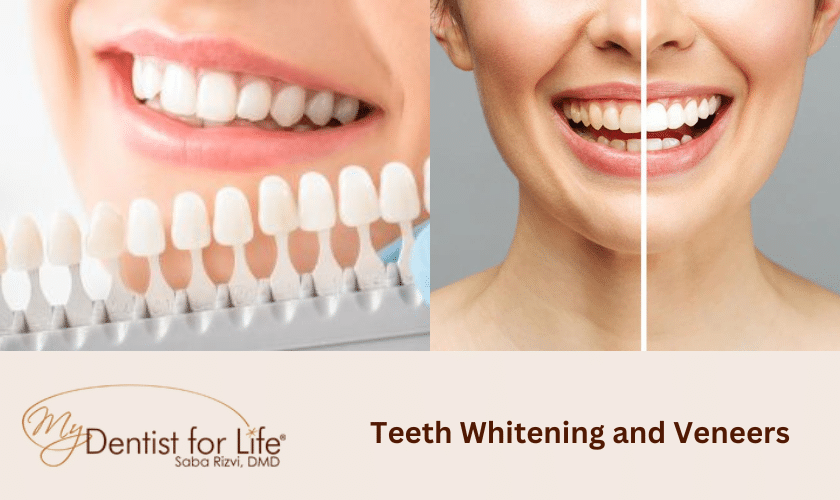ONLINE SCHEDULING AND VIRTUAL CONSULTS AVAILABLE

Teeth Whitening: Safely Enhance Your Smile

A radiant smile can leave a lasting impression, and there’s no denying the confidence that comes with a set of pearly white teeth. As more people seek ways to enhance their smiles, teeth whitening has gained significant popularity. However, with the plethora of products and procedures available today, it’s crucial to understand the science behind teeth whitening to ensure a safe and effective outcome. In this blog, we’ll explore the various teeth whitening options, the science behind the process, potential risks, and tips for maintaining a dazzling smile.
Understanding Cause Of Teeth Discoloration
Before diving into teeth whitening methods, it’s essential to grasp why teeth become discoloured in the first place. Tooth discoloration can occur due to both extrinsic and intrinsic factors:
Teeth Discolouration Due To Extrinsic Factors: These stains affect the outer layer of the tooth, known as enamel, and are caused by external factors like consuming dark-coloured foods and beverages (coffee, tea, red wine), smoking, and inadequate dental hygiene. Extrinsic stains respond well to teeth whitening procedures as the bleaching agents can effectively break down and remove these surface stains.
Effect Of Intrinsic Factors: Intrinsic stains occur within the tooth’s inner structure, called dentin, and are often the result of factors like ageing, genetics, excessive fluoride exposure during tooth development, and certain medications. Intrinsic stains are more challenging to whiten as they are deeper within the tooth. While teeth whitening can still help improve intrinsic stains, it may require more intensive treatments or cosmetic procedures like dental veneers.
Teeth Whitening Options
Over-The-Counter (OTC) Products For Teeth Whitening:
- Use Of Whitening Toothpaste: These toothpaste varieties contain mild abrasives and polishing agents that help remove surface stains. They do not typically contain bleaching agents but can provide some improvement over time.
- Whitening Strips For Teeth Whitening: These thin, flexible strips are coated with a gel containing a low concentration of hydrogen peroxide. They are applied directly to the teeth and left in place for a specified duration, usually a few minutes daily over a few weeks.
- Use Of Whitening Gels And Pens: Whitening gels come in syringes or pens with applicator brushes. They contain peroxide-based gels and are applied directly to the teeth for targeted whitening.
- Whitening Mouthwashes: Some mouthwashes have mild whitening agents to help reduce surface stains and freshen breath.
Dentist-Supervised At-Home Whitening:
Your dentist may provide custom-made trays and a stronger bleaching gel for use at home. You fill the trays with a dentist-prescribed bleaching gel and wear them for a specified amount of time daily. This method offers more noticeable results than OTC products, as the concentration of the bleaching agent is higher.
In-Office Professional Whitening:
Dentists use high-concentration bleaching gels and advanced technologies, such as laser or light-activated systems, to expedite the whitening process. In-office treatments typically provide the most significant improvement in a single session.
Some companies offer LED devices that claim to accelerate the teeth whitening process. These are often used with whitening gels or strips and are intended to enhance the whitening effects.
The Science Behind Teeth Whitening
The active ingredient in most teeth whitening products is either hydrogen peroxide or carbamide peroxide. These bleaching agents penetrate the enamel and dentin, where they break down complex organic molecules responsible for discoloration. Oxygen molecules from the whitening agents react with the stained compounds, causing them to break apart and become less concentrated, resulting in a brighter appearance.
It’s important to note that teeth whitening is most effective on extrinsic stains. Intrinsic stains may require more intensive treatment or cosmetic solutions like dental veneers.
Potential Risks And Precautions To Whitening Teeth
While teeth whitening is generally safe, some individuals may experience mild side effects, such as tooth sensitivity or gum irritation. Adhering to product guidelines and consulting your dentist can mitigate these risks. It’s vital to avoid excessive or prolonged use of over-the-counter products, as this may lead to enamel damage.
Pregnant and nursing individuals, as well as those with severe tooth decay, gum disease, or hypersensitivity, should avoid teeth whitening until they receive approval from their dentist.
Maintaining Your Dazzling Smile
After achieving a brilliant smile, following a few simple practices can help maintain your results:
- Brush and floss regularly to prevent new stains from forming.
- Limit consumption of staining foods and beverages.
- Use a straw when drinking dark-colored liquids to minimise contact with your teeth.
- Quit smoking or using tobacco products.
- Schedule regular dental check-ups and cleanings to monitor your oral health.
At the end, teeth whitening, when done correctly, can be a safe and effective way to enhance your smile and boost your self-confidence. Understanding the science behind teeth discoloration and the various whitening options available will empower you to make informed decisions. Remember to consult your dentist before beginning any teeth whitening regimen and priorities proper oral hygiene to maintain your stunning smile for years to come.





